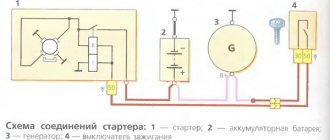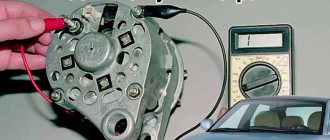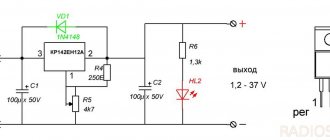During the operation of a car, problems with the battery and generator often arise. Often, the battery may fail due to insufficient charge. This problem is relevant both for many foreign cars, especially with mileage, and for various domestic cars (VAZ, GAZ, ZAZ, etc.).
For normal operation of a car battery, it is necessary that the generator charges the battery while the engine is running, and neither undercharging nor overcharging of the battery is allowed. Next, we will look at problems with battery charging using the example of a VAZ 2106, the charging relay on this car model, and also how to check the VAZ regulator relay yourself.
Charging relay on a VAZ: purpose and symptoms of malfunction
So, the battery charge relay or the VAZ generator relay-regulator is responsible for ensuring that the car’s battery is charged “correctly” from the generator. In fact, a car alternator has a diode bridge (rectifier unit) to convert alternating current to direct current.
It is important that the voltage remains constant, regardless of the rotation speed of the generator, which changes. For this purpose, a generator voltage regulator relay or charging relay 2106 is used separately. This device is responsible for the constant voltage in the on-board network at around 12V.
Without a regulator, there will be voltage surges, “dips” and “rises” (for example, 9V - 30V). Of course, in this case, many energy consumers will simply burn out, and problems will begin with the battery charge and the battery itself.
- If we talk about malfunctions, the regulator relay on a VAZ and other cars does not fail very often, but the possibility of such a breakdown cannot be ruled out. As a rule, failure is usually indicated by the fact that the battery stops charging, while the generator operates normally. However, this is not all, as there are other symptoms and signs of a broken voltage regulator.
Often, if the regulator is faulty, the voltage on the battery begins to deviate from the norm. As a result:
- the battery does not charge or does not charge completely (usually the reason is a broken regulator relay).
- the battery is boiling, which indicates a breakdown of the regulator relay and that the charging current to the battery is higher than normal, the battery is overcharged and is boiling.
At the same time, both the first and second cases are a problem, you won’t be able to operate the car normally, the battery quickly fails, etc. In fact, if the VAZ voltage regulator relay is faulty, checking allows you to quickly determine the cause.
Connecting the unit
Before discarding the device, you should make sure that other parts are in good condition. The belt, alternator, battery, and wires are subject to inspection. The lack of charging of the VAZ 2106 may be caused by a loose belt. If the unit was removed before checking, you should make sure that the wires are connected correctly.
Replacing the voltage regulator is done in a garage. Even an inexperienced driver can do this. You will need a tool, skillful hands and a little knowledge.
Open the hood to find the remote relay. In the Zhiguli, the box is attached with lugs to the left wing. We find the object near the brake fluid reservoir. Some relays are built into the generator housing. People call them integrals.
Do not rush to remove the wiring from the terminals. Experienced car enthusiasts are advised to first mark the wires with a marker. There are 2 gray and orange wires suitable for the VAZ voltage regulator. They are attached to terminals numbered 67 and 15. Do not mix up the wires. The gray color corresponds to the number 67, and the orange color corresponds to 15.
Problems with the battery: charging the VAZ 2106 and diagnosing faults
As a rule, before checking the regulator of a VAZ 2107, 2106 or any other car, it is necessary to review in general terms the design and operating principle of such a regulator.
Let's start with the fact that the design of the regulator may differ. Old VAZ 2106 models have outdated contact regulators. At the same time, newer versions already use an electronic regulator.
- So, the contact external regulator is still the basis. This is a semiconductor type device manufactured on a single board. The main element is the winding (brass wire is used), the winding consists of just over a thousand turns, and there is a copper core inside the winding. The winding has a constant resistance of 16 ohms.
The regulator also uses a group of tungsten contacts, an adjustment plate, and a magnetic shunt. A set of resistors is used in parallel, and their connection differs depending on what voltage is required. The resistors provide a maximum resistance of 75 ohms. All components are located in a textolite case, with contacts for connection brought out.
Let's move on. When the internal combustion engine starts, the crankshaft rotates, from which the attachments are also driven. The generator on many cars is no exception, that is, the rotor in the generator is also driven by the engine. So, when the engine rotates at a frequency of about 2 thousand rpm, the voltage at the generator outputs is no higher than 13 Volts.
In this case, the regulator does not turn on; the current goes directly to the excitation winding. However, when the engine rotation speed increases, as well as the generator rotor, the voltage regulator automatically turns on.
On a VAZ 2106, the relay regulator is connected to the generator brushes, as well as to the ignition switch. Also, the winding connected to the generator brushes actively reacts to the fact that the internal combustion engine speed increases and, as a result of such an increase, becomes magnetized.
Next, the core in the winding is pulled inward, which leads to the opening of the contacts on the internal resistors of one group and the closure of the contacts on the resistors of the other group. For example, when the speed is not high, only one resistor in the regulator remains closed, while when operating at high speeds, three resistors are closed, and the voltage on the excitation winding drops significantly.
What is it, where is it located, how does it work
This part of the car is responsible for maintaining the voltage of the on-board network within certain limits. The regulator controls the ambient temperature, rotor speed, electrical load level and other parameters. It also protects the sensitive elements of the generator from overloads and is responsible for activating the field winding and other systems.
The product is located directly in the generator. Regardless of the machine model, the principle of operation of the regulator is the same - when the voltage increases or decreases, the component reduces or increases the excitation current to return the indicators to the desired level.
This is what the voltage regulator looks like
How to check the generator relay regulator with your own hands
Having examined the device and principle of operation, you can proceed to testing. It is noteworthy that it is quite possible to check the relay regulator in an ordinary garage. To do this, you need to have a regular multimeter with a scale of up to 35 volts, a set of wrenches and screwdrivers.
- A simple method for checking the generator regulator on a VAZ 2106 assumes the following: a well-charged battery is needed for testing. To perform diagnostics, you need to start the internal combustion engine, turn on the headlights and leave the engine running for 10-15 minutes, while the engine speed does not increase above 2 thousand rpm. Next, you need to use a multimeter to measure the voltage between the battery terminals. The norm is no higher than 14 Volts and no lower than 12 Volts.
If the voltage deviates from the norm, this indicates problems with the relay regulator. Considering that this device cannot be repaired, it needs to be replaced. Replacement involves removing (you need to unscrew a couple of bolts) and installing a new regulator.
- The second test method should be used when the problem is “floating” (the voltage at the battery terminals is slightly less than 12 Volts or slightly higher than 14 Volts). In such a situation, the regulator must be checked separately by removing it. To check, use a multimeter and a 12 volt light bulb.
Having examined the regulator of the VAZ 2106 generator, you can find a pair of outputs (on the diagrams often marked with the letters B and C). The indicated contacts must be supplied with power from the battery. Two more relay contacts go to the generator brushes. A lamp is connected to the indicated contacts.
If the voltage at the outputs when power is supplied from the battery is not higher than 14 volts, the light will light brightly. If you use a multimeter to increase the voltage at the power supply outputs to 15 volts or higher, the light should go out. If this does not happen, then the regulator has failed. If the light does not light up initially, both in the first and second cases, then the relay needs to be changed.
- Replacing the VAZ 2106 generator regulator involves selecting a suitable device. It is important to immediately determine what type of device is on the generator (external regulator, internal regulator). The external regulator is located on the front left arch (in the area of the front wheel). The internal regulator is removed after removing the air filter, since the filter blocks access to the generator.
The external regulator can be easily removed (just unscrew the two 10mm bolts holding the relay with an open-end wrench), after which the wires are disconnected. Assembly is carried out in reverse order. The internal regulator is a little more complicated, since you first need to unscrew three 12 nuts. The internal regulator itself is located on the front cover of the generator, secured with two bolts. The bolts are unscrewed with a screwdriver.
Then the relay is carefully pulled out of the generator cover, after which the wires and contact block are removed. When removing the block, special care must be taken, since the contacts are fragile. Next, a new regulator is installed and reassembled.
We also recommend reading the article about why the battery icon on the instrument panel is lit. In this article, you will learn about the main reasons why the battery lights up on the dashboard, as well as how to detect and fix the problem.
- Please note that external regulators for the VAZ 2106 are almost impossible to find new for sale. We have to pay for used devices. So, the real condition of such a regulator is difficult to visually determine, that is, a check is necessary before purchasing (you can use the methods discussed above).
Regarding internal regulators, the main problem is the wires connected to the relay from the generator. Very often, when replacing, they break in the area of the contact block. If this happens, you will need to cut the block, resolder the wires, make high-quality insulation, and then glue the block back together.
To avoid such problems, when replacing the internal regulator of the VAZ 2106 generator, you need to be extremely careful, do not repair the car in the cold, since the wires break more easily in such conditions, etc.
Let's sum it up
As you can see, the generator relay for a VAZ or any other car is an important and responsible device. Moreover, any malfunctions in its operation will lead to the fact that the car’s battery will not be charged properly. In this case, both low and high battery charge will quickly damage the battery.
We also recommend reading the article about what to do if the electrolyte in the battery freezes. From this article you will learn why the electrolyte in the battery freezes, as well as what to do if the car battery freezes.
If the signs of a generator regulator failure discussed above appear to a greater or lesser extent, it is necessary to check the regulator using one of the methods discussed above. Finally, we note that it is not difficult to replace the generator voltage regulator on a VAZ, but some nuances must be taken into account separately.
Types of structures
There are 2 types of regulators: old and new. They replace each other, although they contain different fillings. The old design is equipped with a mechanical relay. VAZ cars are equipped with a voltage regulator of the PP-380 type. Devices of this series use moving contacts to switch on resistors.
This spare part has been removed from mass production. Nowadays such specimens are rare. The vibration regulator PP-380 also has a number of disadvantages. Let us point out the difficulties in operating the contact option:
- need for customization;
- step adjustment;
- periodic cleaning of the contact group;
- low reliability;
- creates radio interference;
- short service life.
Today, semiconductor technologies have replaced the outdated model. Cars produced by VAZ, GAZ, UAZ are equipped with electronic developments. The innovation is a huge merit and success of Russian manufacturers.
Regulators based on transistors are classified as non-contact relays. VAZ 2106 received a block of type 121.3702. The radio components are housed in a rectangular plastic case.











